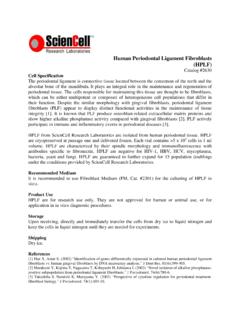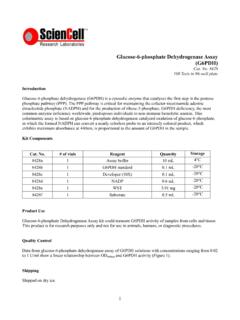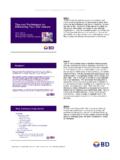Transcription of Human Splenic Endothelial Cells - Primary Cells, …
1 Human Splenic Endothelial Cells (HSEC) Catalog #5500 Cell Specification The spleen performs essential functions in the turnover of erythrocytes. It removes erythrocytes, metabolizes hemoglobin, and recycles iron. The spleen also mounts a Primary immune response to antigens in the blood and synthesizes antibodies in its white pulp. Human Splenic Endothelial Cells (HSEC), similar to other Endothelial Cells , constitute the natural interface between the blood and the underlying tissue. Previous studies have demonstrated an intriguing link between Splenic Endothelial Cells , Splenic hamartoma and capillary hemangioma [1]. Splenic Endothelial Cells have also shown a supportive micro-environment for the development of dendritic Cells [2]. Furthermore, rapid destruction of young erythrocytes can occur in the spleen due to altered Endothelial cell-macrophage interactions [3].
2 These observations suggest that Splenic Endothelial Cells may play a more compelling role in the mononuclear phagocyte system. HSEC from ScienCell Research Laboratories are isolated from Human spleen. HSEC are cryopreserved at passage one and delivered frozen. Each vial contains >5 x 105 Cells in 1 ml volume. HSEC are characterized by immunofluorescence with antibodies specific to VWF/Factor VIII and CD31 (PECAM). HSEC are negative for HIV-1, HBV, HCV, mycoplasma, bacteria, yeast and fungi. HSEC are guaranteed to further expand for 15 population doublings under the conditions provided by ScienCell Research Laboratories. Recommended Medium It is recommended to use Endothelial Cell Medium (ECM, Cat.)
3 #1001) for culturing HSEC in vitro. Product Use HSEC are for research use only. They are not approved for Human or animal use, or for application in in vitro diagnostic procedures. Storage Upon receiving, directly and immediately transfer the Cells from dry ice to liquid nitrogen and keep the Cells in liquid nitrogen until they are needed for experiments. Shipping Dry ice. References [1] Zukerberg LR, Kaynor BL, Silverman ML, Harris NL. (1991) Splenic hamartoma and capillary hemangioma are distinct entities: immunohistochemical analysis of CD8 expression by Endothelial Cells . Hum Pathol. 22: 1258-61. [2] Despars G, O'Neill HC. (2006) Splenic Endothelial cell lines support development of dendritic Cells from bone marrow. Stem Cells .
4 24: 1496-504. [3] Trial J, Rice L, Alfrey CP. (2001) Erythropoietin withdrawal alters interactions between young red blood Cells , Splenic Endothelial Cells , and macrophages: an in vitro model of neocytolysis. J Investig Med. 49: 335-45. Instructions for culturing Cells Caution: Cryopreserved Cells are very delicate. Thaw the vial in a 37oC water bath and return the Cells to culture as quickly as possible with minimal handling! Initiating the culture: 1. Prepare a fibronectin coated flask (2 g/cm2, T-75 flask is recommended). Add 10 ml of sterile Dulbecco s phosphate buffered saline (DPBS, Ca++ and Mg++ free, Cat. #0303) to a T-75 flask and then add 150 l of fibronectin stock solution (1 mg/ml, Sigma Cat. #F1141). Leave the flask in incubator overnight.
5 2. Prepare complete medium. Decontaminate the external surfaces of medium bottle and medium supplement tubes with 70% ethanol and transfer them to a sterile field. Aseptically transfer supplement to the basal medium with a pipette. Rinse the tube with medium to recover the entire volume. 3. Aspirate fibronectin solution and add 15 ml of complete medium to the flask. Leave the flask in the hood and proceed to thaw the cryopreserved Cells . Fibronectin solution can be reused twice. 4. Place the frozen vial in a 37oC water bath. Hold and rotate the vial gently until the contents completely thaw. Remove the vial from the water bath promptly, wipe it down with 70% ethanol and transfer it to the sterile field. 5.
6 Remove the cap carefully without touching the interior threads. Gently resuspend and dispense the contents of the vial into the equilibrated, fibronectin coated culture vessel. A seeding density of 5,000-7,000 Cells /cm2 is recommended. Note: Dilution and centrifugation of Cells after thawing are not recommended since these actions are more harmful to the Cells than the effect of residual DMSO in the culture. It is also important that Cells are plated in fibronectin coated culture vessels to promote cell attachment. 6. Replace the cap or lid, and gently rock the vessel to distribute the Cells evenly. Loosen cap if necessary to allow gas exchange. 7. Return the culture vessel to the incubator. 8. For the best result, do not disturb the culture for at least 16 hours after the culture has been initiated.
7 Refresh culture medium the next day to remove the residual DMSO and unattached Cells , then every other day thereafter. Maintaining the culture: 1. Refresh supplemented culture medium the next morning after establishing a culture from cryopreserved Cells . 2. Change the medium every three days thereafter, until the culture is approximately 70% confluent. 3. Once the culture reaches 70% confluency, change medium every other day until the culture is approximately 90% confluent. Subculturing: 1. Subculture when the culture reaches 90% confluency. 2. Prepare fibronectin coated culture vessels (2 g/cm2) one day before subculture. 3. Warm complete medium, trypsin/EDTA solution (T/E, Cat. #0103), T/E neutralization solution (TNS, Cat.)
8 #0113), and DPBS (Ca++ and Mg++ free, Cat. #0303) to room temperature. We do not recommend warming reagents and medium at 37oC water bath prior use. 4. Rinse the Cells with DPBS. 5. Add 10 ml of DPBS and then 1 ml of T/E solution into flask (in the case of T-75 flask). Gently rock the flask to ensure complete coverage of Cells by T/E solution. Incubate the flask at 37oC incubator for 1 to 2 minutes or until Cells completely round up. Use microscope to monitor the change in cell morphology. 6. During incubation, prepare a 50 ml conical centrifuge tube with 5 ml of fetal bovine serum (FBS, Cat. #0500). 7. Transfer T/E solution from the flask to the 50 ml centrifuge tube (a few percent of Cells may detached) and continue to incubate the flask at 37oC for another 1 to 2 minutes (no solution in the flask at this moment).
9 8. At the end of incubation, gently tap the side of the flask to dislodge Cells from the surface. Check under microscope to make sure that all Cells detach. 9. Add 5 ml of TNS solution to the flask and transfer detached Cells to the 50 ml centrifuge tube. Rinse the flask with another 5 ml of TNS to collect the residual Cells . 10. Examine under microscope for a successful cell harvest by looking at the number of Cells being left behind. There should be less than 5%. Note: Use ScienCell T/E solution that is optimized to minimize cell damages due to over trypsinization. 11. Centrifuge the 50 ml centrifuge tube at 1000 rpm for 5 min. Resuspend Cells in culture medium. 12. Count and plate Cells in a new, fibronectin coated culture vessel with cell density as recommended.
10 Caution: Handling Human derived products is potentially biohazardous. Although each cell strain tests negative for HIV, HBV and HCV DNA, diagnostic tests are not necessarily 100% accurate, therefore, proper precautions must be taken to avoid inadvertent exposure. Always wear gloves and safety glasses when working with these materials. Never mouth pipette. We recommend following the universal procedures for handling products of Human origin as the minimum precaution against contamination [1]. [1] Grizzle WE, Polt S. (1988) Guidelines to avoid personal contamination by infective agents in research laboratories that use Human tissues. J Tissue Cult Methods. 11: 191-9.









